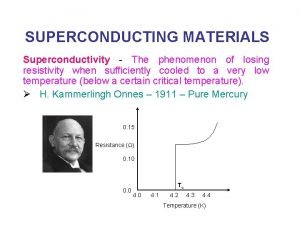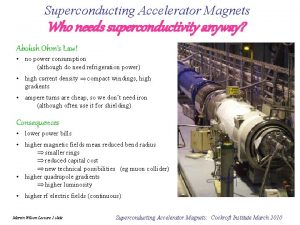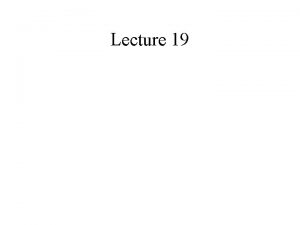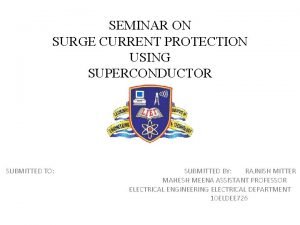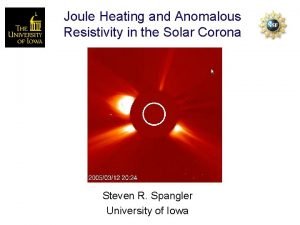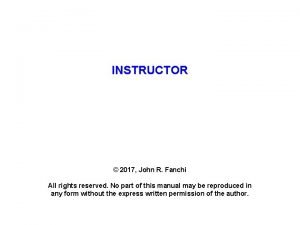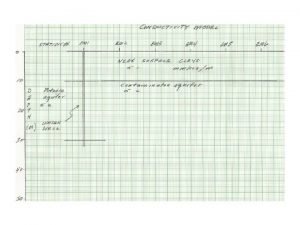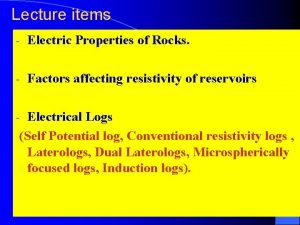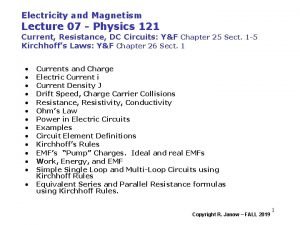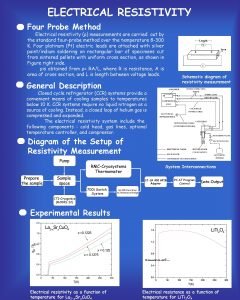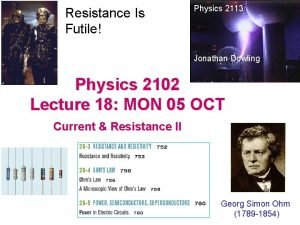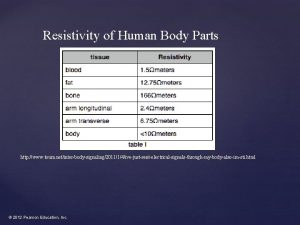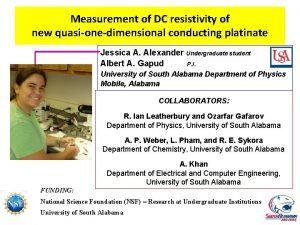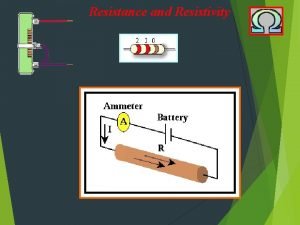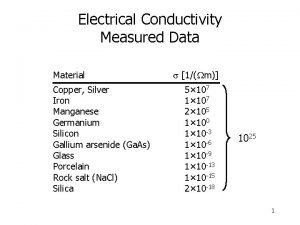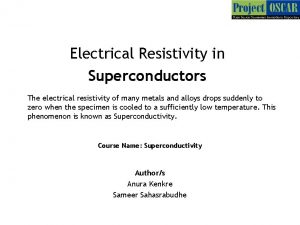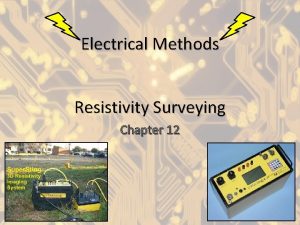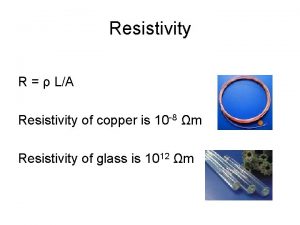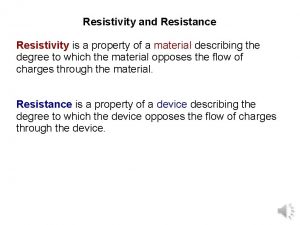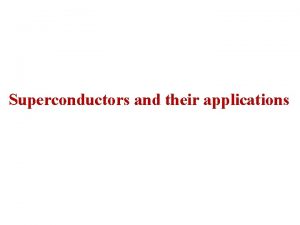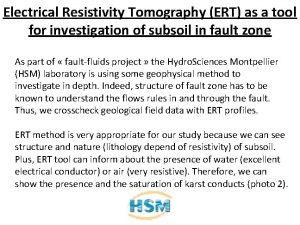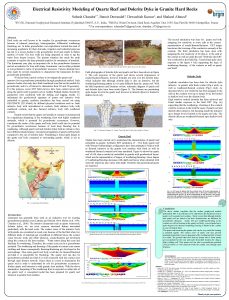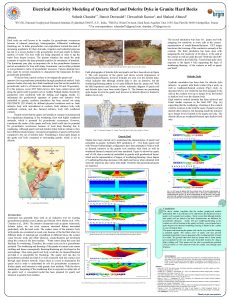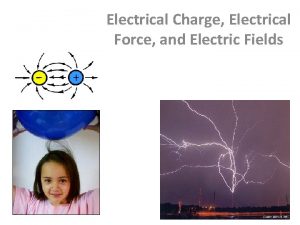Electrical Resistivity in Superconductors The electrical resistivity of


























- Slides: 26

Electrical Resistivity in Superconductors The electrical resistivity of many metals and alloys drops suddenly to zero when the specimen is cooled to a sufficiently low temperature. This phenomenon is known as Superconductivity. Course Name: Superconductivity Author/s Anura Kenkre Sameer Sahasrabudhe

1 Learning objectives 2 3 4 5 After interacting with this Learning Object, the learner will be able to: – Explain the meaning of electrical resistivity in superconductors. – Predict the effect of temperature changes on the electrical resistivity of superconducting samples.

1 2 3 4 5 Definitions and Keywords The electrical resistivity of many metals and alloys drops suddenly to zero when the specimen is cooled to a sufficiently low temperature. This phenomenon is known as Superconductivity. The temperature at which the transition to the superconducting state takes place is called the critical temperature(Tc)or the superconducting transition temperature. Add more slides if required

Slide only for reference: : NOT TO BE ANIMATED 1 Master Layout: A: Circuit diagram Ammeter reading Ammeter 2 3 Voltmeter Temperature Control 4 Temperature reading 5 reading Voltmeter

Slide only for reference: : NOT TO BE ANIMATED 1 Master Layout: B: Visual representation 2 3 4 Path on which the electrons are moving 5

Slide only for reference: : NOT TO BE ANIMATED 1 Master Layout: C: Graph 2 Blinking red dot denoting: Temperature 3 4 5

Electrical Resistivity in Superconductors Introduction Tab 02 Tab 03 Tab 04 Tab 05 Tab 06 1 Tab 07 Microscopic view Change the temperature and observe the motion of electrons in the Microscopic view Graphical representation Instructions/ Working area Credits

Electrical Resistivity in Superconductors Introduction Tab 02 Tab 03 Tab 04 Tab 05 Tab 06 2 Tab 07 Microscopic view Graphical representation Instructions/ Working area Credits

Electrical Resistivity in Superconductors Introduction Tab 02 Tab 03 Tab 04 Tab 05 Tab 06 3 Tab 07 Microscopic view Graphical representation Instructions/ Working area Credits

Electrical Resistivity in Superconductors Introduction Tab 02 Tab 03 Tab 04 Tab 05 Tab 06 4 Tab 07 Microscopic view Graphical representation Instructions/ Working area Credits

Slide only for reference: : NOT TO BE ANIMATED 1 2 3 4 5 Analogy / Scenario / Action

1 Step 1: T 1: Title of the step, to appear as heading of the screen (if any) 2 Screen as shown in Slide 7 3 Description of the Action / Interactivity 4 1. 2. 3. 4. 5 Show the Animation design screen (Slide 7) The temperature meter shows T= 4. 4 K as shown. The electrons are seen moving in the 'microscopic view window. (They are at their fastest speed at this setting) A pop up will appear on the ‘Click to change the temperature' – If the user clicks on ‘click to go to lower temperature', go to Step 2 (Slide 8) – If the user to clicks 'click to go to higher temperature', show the feedback pop-up 'Making it more would be. . . so try to lower it'. Audio Narration (if any) Click on these buttons to change the temperature Text to be displayed (if any)(DT)

1 Step 1: T 1: Title of the step, to appear as heading of the screen (if any) 2 Screen as shown in Slide 7 3 Description of the Action / Interactivity 4 1. 2. 3. 5 Show the changes in A, B and C as per the slide numbers: 8, 9, 10 Keep the unit of change to 0. 5, and decrease the speed of the electrons respectively. – Ex: 4. 4, 4. 35, 4. 3, 4. 25, 4. 2, 4. 15, 4. 1, 4. 05, 4. 0, 3. 95, 3. 9, 3. 85. . . etc Show the appropriate feedback, based on the temperature selected by the user – Ex: for all the settings above 4. 4, display: ------– For all the settings below 4. 15, display: ------ Audio Narration (if any) Text to be displayed (if any)(DT) 1. Display this if the temperature is lowered: If the temperature is lowered, you can se that the electrons move slower.

1 Step 1: T 1: Title of the step, to appear as heading of the screen (if any) 2 Screen as shown in Slide 7 3 Description of the Action / Interactivity 4 1. 2. 3. 5 Set the specific limit for the interactivity to --- attempts. Ensure the correctness of the 'feedback' to be displayed for every attempt which is OUTSIDE the chosen range for this particular sample – Ex: 4. 4 to 4. 15 After the ---attempts. Display a box with: 'Answer the questions in the following questionnaire to test your understanding' Change the screen to the animation design slide number XX and display the questionnaire. Audio Narration (if any) Text to be displayed (if any)(DT)

1 Step 1: T 1: Title of the step, to appear as heading of the screen (if any) 2 Screen as shown in Slide 7 3 Description of the Action / Interactivity 4 5 1. 2. Display appropriate feedback for the answers submitted by the user. After the user finishes the questionnaire, display the summary as given in slide XX Audio Narration (if any) Text to be displayed (if any)(DT)

1 Step 1: T 1: Title of the step, to appear as heading of the screen (if any) 2 Screen as shown in Slide 7 3 Description of the Action / Interactivity 4 5 1. 2. Display appropriate feedback for the answers submitted by the user. After the user finishes the questionnaire, display the summary as given in slide XX Audio Narration (if any) Text to be displayed (if any)(DT)

1 Interactivity option 1: Step No: 1 Image/graphic for explaining the interactivity options 2 3 4 5 Interactivity type Instruction to the learner Boundary limits Lowest for showing animation in 'B' is ______ Highest for showing animation in 'B'is ______ Instructions for the animator 1. 2. Interactivity options in this animation is already explained in STEPS earlier. Please follow them Results and Output

APPENDIX 1 Questionnaire: The questions along with the answer options are given in the next few slides Justification is also provided for the incorrect answers, which has to be displayed in case the user selects incorrect answers.

APPENDIX 2 Links for further reading Reference websites: http: //www. msm. cam. ac. uk/doitpoms//tlplib/index. php Books: Introduction to Solid state physics-Charles Kittel(Chapter 12) Solid state physics-MA Wahab. (Chapter 17) Solid state physics-Ashcroft/Mermin. (Chapter 34)

Questionnaire 1. At what temperature does the sample enter the superconducting state? Answers: a) 4. 4 K d)4. 10 K b) 4. 3 K c) 4. 15 K Correct Answers: 1)C Feedback: If user clicks correct answer then display “Correct! Make sure you can explain the reasoning!” If user clicks incorrect answer then display “Have a look at the animation and Try again! ” 20

Questionnaire 2. What happens to the resistivity of the sample as the temperature decreases? Answers: a) increases d)becomes zero b) decreases c) remains same Correct Answers: 2)b Feedback: If user clicks correct answer then display “Correct! Make sure you can explain the reasoning!” If user clicks incorrect answer then display “Have a look at the animation and Try again! ” 21

Questionnaire 3. What happens to the resistivity of the sample at the transition temperature? Answers: a)increases d)becomes zero b) decreases c) remains same Correct Answers: 3)d Feedback: If user clicks correct answer then display “Correct! Make sure you can explain the reasoning!” If user clicks incorrect answer then display “Have a look at the animation and Try again! ” 22

Questionnaire 4. What happens to the resistivity of the sample below the transition temperature? Answers: a) returns to normal is zero d)increases a lot. b) decreases further c)it Correct Answers: 4)c Feedback: If user clicks correct answer then display “Correct! Make sure you can explain the reasoning!” If user clicks incorrect answer then display “Have a look at the animation and Try again! ” 23

Questionnaire 5. What happens to the number of collisions between the electron and the atoms of the lattice as the temperature decreases? Answers: a) increases d)becomes zero. b) decreases c)remains constant Correct Answers: 5)b Feedback: If user clicks correct answer then display “Correct! Make sure you can explain the reasoning!” If user clicks incorrect answer then display “Have a look at the animation and Try again! ” 24

1 Questionnaire 6. What happens to the electrons when the material enters the superconducting state? 2 Answers: a)each electron flows through the sample without any resistance b)each electron flows through the sample with lot of resistance 3 4 5 c)Two electrons pair up and flow together through the sample without any resistance. d)Two electrons pair up and flow through the sample with lot of resistance. Correct Answers: 6)c Feedback: If user clicks on correct answer then display ”Yes !The electrons pair up and flow through the sample together. These pair of electrons are known as Cooper Pairs. Have a look at the animation on Cooper Pairs to get a better understanding of this concept. ” If user clicks incorrect answer then display “Have a look at the animation and Try again!” 25

APPENDIX 3 Summary When you reduce the temperature sufficiently, certain metals conduct electricity without any resistance. This phenomenon is known as Superconductivity. The resistivity of the metals goes on reducing as you lower the temperature and becomes zero at the superconducting transition temperature. The temperature at which the transition to the superconducting state takes place is called the critical temperature(Tc)or the superconducting transition temperature. When the metal enters the superconducting state, the electrons in the metal pair up and flow through the sample together. These pair of electrons are known as Cooper Pairs.
 What are superconductors
What are superconductors Superconductivity
Superconductivity Superconductors
Superconductors Persistent currents
Persistent currents Surge current protection using superconductors
Surge current protection using superconductors Surge current protection using superconductors
Surge current protection using superconductors Spitzer resistivity
Spitzer resistivity Resistivity log
Resistivity log Resistivity unit
Resistivity unit Factors affecting resistivity of rocks
Factors affecting resistivity of rocks Is 121
Is 121 Resistivity by four probe method
Resistivity by four probe method Ohm's law microscopic form
Ohm's law microscopic form Specific resistance
Specific resistance Resistivity of human body
Resistivity of human body Kcp
Kcp Unit of resistivity
Unit of resistivity Resistivity units
Resistivity units Electrical resistance formula
Electrical resistance formula Cz silicon wafer with high resistivity
Cz silicon wafer with high resistivity Từ ngữ thể hiện lòng nhân hậu
Từ ngữ thể hiện lòng nhân hậu Hươu thường đẻ mỗi lứa mấy con
Hươu thường đẻ mỗi lứa mấy con Diễn thế sinh thái là
Diễn thế sinh thái là Vẽ hình chiếu vuông góc của vật thể sau
Vẽ hình chiếu vuông góc của vật thể sau 101012 bằng
101012 bằng Tỉ lệ cơ thể trẻ em
Tỉ lệ cơ thể trẻ em Lời thề hippocrates
Lời thề hippocrates

